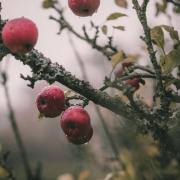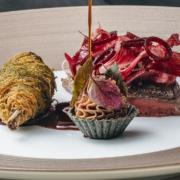A homemade recipe for pesto linguine with rocket salad

Pesto is an extremely versatile sauce and when you quickly master your own method for concocting it, you’ll discover it can be used in an infinite variety of ways. You’ll never have a boring supper dish when pesto is on the menu.
As with all great Italian dishes pesto is regional, traditionally being alla Genovese, or from the city of Genoa in the Liguria region of Italy, which is in itself famous for its olive oil. For Liguria think turn left at the Côte d’Azur.
The Italians are undisputed masters of the kitchen, they rely on simple, quality ingredients for much of their cooking. Even so their cuisine is every bit the equal in sophistication, delivery and taste of; French, Chinese, Japanese, Indian or Mexican cuisines, which may use a number of more complicated or exotic ingredients, for cooking their classic dishes, but the results are no greater than those of Italian cuisine.
The best and most effective way for creating a delicious pesto is by using a pestle and mortar. Pesto is a sauce which absolutely cannot be faked, it needs to be tasted and tested and adjusted accordingly in the process of forming. It takes the cook’s judgement as to the correct proportions of ingredients to each other. No two pesto sauces will taste exactly the same. This unctuous Italian sauce also relies on the best of ingredients, there can be no scrimping at all; there is no shortcut to a great pesto.
INGREDIENTS
Extra Virgin Olive Oil
1-2 Cloves of Garlic (optional)

Pine Nuts
Fresh Basil Leaves
Parmesan Cheese
Cornish Sea Salt
Pepper
METHOD OF COOKING
Take a dry, clean non-stick frying pan and add a handful of pine nuts, then gently toast the nuts until they release their oils. You only want them to turn a little golden, be careful to stand guard over them a take them off immediately before they start to burn.

Place the pine nuts in the mortar (the bowl part, the pounder is the pestle). If you are using the garlic then place the peeled clove, or cloves, in the mortar beforehand. Sprinkle in some coarse Cornish sea salt on the pine nuts and garlic before pounding into a paste with the pestle. Be careful not to add too much salt as parmesan cheese contains a good deal of saltiness.
Next add the fresh basil leaves, don’t be stingy with these add a whole plant at least, though more may be required. Basil can be easily grown on kitchen windowsills during our mild Cornish winters. Leave in the sunshine of a garden, or window box, during the summer. Pound the basil leaves into a paste with the garlic and pine nuts and then add a grateful helping of Parmesan cheese of the Parmigiano-Reggiano classification. If it isn’t made in the designated and protected region for this cheese then it ain’t proper Parmesan. With this cheese, always buy the best quality you can get and afford.
After working on the cheese with the pestle, start adding the extra virgin olive oil, once again buy the best quality possible and make sure it is extra virgin and not the everyday olive oil you normally cook with extra virgin, cold pressed is best.
When the pesto is all thoroughly mixed together with the required consistency, then taste and adjust for the correct seasoning.
Pesto can be used as a sauce with many different types of pasta, though my favourites are spaghetti or linguini. The sauce can be added cold to the hot pasta, or placed in a pan to warm through by adding some of the liquor the pasta was cooked in. If adding the pesto cold, save some of the cooking liquid anyway as it always gives the pasta a nice sheen.
Pesto works fantastically well with my favourite salad Insalata Caprese. This is a very simple Italian dish from the region of Campania made, once again, with the finest ingredients. Simply slice some mozzarella di bufala and some beef tomatoes and line them up together on a plate, then drizzle the pesto on top of the cheese and fruit. I normally leave the garlic out of the pesto when serving in this manner because I find its zingy hum can overpower the other more subtle flavours of this salad. However, an accompaniment of garlic crostini is always a welcome addition to this perfect Spring/Summer lunch.
A crostini, in itself, is the perfect place to spread some pesto. This works better if the pesto is a little more dense. Take some ciabatta, or sourdough bread and drizzle with olive oil before placing on a baking try in the oven or on a hot griddle. Once the bread is cooked smear the pesto across it for a truly moreish supper dish.
Pesto is also great as an all purpose salad dressing. Make sure the pesto has plenty of extra virgin olive oil added, to loosen it significantly for drizzling and you could also add a squeeze of fresh lemon to jazz it up and add a springy, sour note to cut through the richness of the sauce. No matter how you serve it, homemade pesto will always bring some Mediterranean sunshine to your day. Buon Appetito!



























